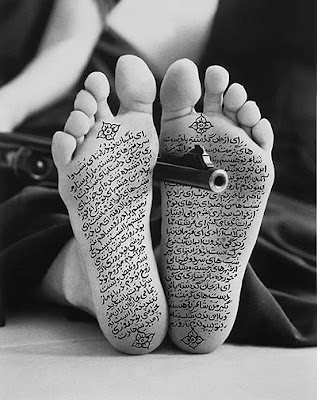I don’t want to be boring with bios and references, more here and here.
First of all I’d like to reconstruct your own identity, were you born in England?
Yes, I was born in Doncaster.
And your parents?
My parents were born in India, but they moved to Pakistan, so they would say they’re from Karachi, Pakistan.
Have you ever been there?
Yeah, when I was young I used to go to Pakistan every couple of years, last time was probably about four years ago.
Have you ever play there?
I’ve never played music there.
Have you come across any interesting music there?
In Karachi I have been to couple of small rooftop qawwalis – kind of religious devotional music with vocals, harmonium and tablas. They were pretty intense performances. A few of the people in the audiences were freaking out, throwing themselves around, shouting and singing and getting into trance like states. After the first one of these performances everyone went downstairs to eat together. Afterwards everyone seemed to get up, arrange themselves in a circle, hold hands and slowly moving round. Every so often one person would step forward into the middle of the circle and start reciting something in Arabic and then rejoin the circle. Everyone would move round a bit and the next person would step forward recite something and so on. As soon as I realised that soon it would be by turn to enter the circle and says something I was panic stricken. I didn’t know what to say. Anyway when my turn came I just recited one the short verses from the Quran I knew and no one asked me to leave.
Whilst driving through the North Western Pashtun areas I came across some pretty amazing music performances. Once driving through a forest roads I came across a group of young Pashtuns just at the edge of the forest with a couple of harmoniums and a couple of drums playing some amazing folk songs. Most of them were dancing around giggling and falling over. They looked pretty intoxicated but I am not sure.
I am really interested in how do you decide to portrait yourself. After being spoken about your identity, I’d like to switch to your visual identity; for example, I see often you use a picture by Shirin Neshat to portray yourself, and I’d like to ask you why you do it.
I am not sure if there is a concrete cohesive structure or idea behind any of these. To be honest I don’t know anything about Shirin Neshat and was not aware of who had taken the picture or in what context before you mentioned it. There was something I liked about the picture. I am not sure but it looks like an Quranic prayer written on her feet which is pretty blasphemous. Feet are considered to be relatively impure and should not touch or even face the Quran or religious artifacts. Then there is a barrel of a gun sticking out from between the feet like a middle finger.
Shirin Neshat is an iranian visual artist and filmmaker, and to me that picture looks a little bit disconnected to your music, I mean, if I listen to your music while I see her art pieces, I find myself quiet uncomfortable, as long as she has always work on dialogic oppositions, like male/female, east/west and so, often in a stereotyped way; on the opposite, when I listen to your productions, I really feel lost, as I’m not able to recognize the sources, the originals, but only the half-cast, final object.
I am perhaps as interested in the bits between these dialectic oppositions as the essential ideas themselves. Where two ideas or disciplines meet and the delineations and often even the essential ideas themselves become less distinct.
As I mentioned I don’t think there is an overriding guiding principle or interest. There may be a reaction to something or an interest in something else at some point but then the focus may shift or be intersected by something else.
I have been interested in people like Don Cherry, Ennio Moriconne, Rahul Dev Burman who perhaps display some of these characteristics.
This picture also bring me to another artist, an english musician called Muslimgauze, do you know him?
Yes, I do. I’ve not actually heard much of his music. What I have heard is layers of found sounds and beats underlying.
Yeah, but it’s not so immediately defined, as he has produced more than a hundred of records, the releases are not yet over, even after his death. He touched very different types of music.
I would like to explore his stuff a bit more. The song titles I have come across have been interesting. Playing around with stereotypes and references to Palestinian resistance.
Do you think I sound like Muslimgauze?
No, my point is more into visual relationship in this case. He used a lot of Neshat’s pictures for his covers, and as her, I find him extremely sinked in stereotypes in terms of the pictures he – or people at Staalplaat – choose for the covers. Again, I feel a distance compared to your work, even if I can hear some similitaries between your music and Muslimgauze’s one. For instance I wonder if you both uses the same methods of recording: last night during your performance, I heard a lot of overloaded sounds, such as Muslimgauze did in many pieces. In this way of recordings I can feel the real meaning of ‘distance’. What do you think about?
I’ve not heard very much Muslimgauze at all and I am not sure how he recorded or whether there was a strict ethic or code to which he adhered consistently. The stuff I have heard has been beat orientated with layers of samples using some sort of computer software. I am not sure if I have strict code that I stick to. Its usually recorded on a dictaphone or one of those old multitracker things as live as possible sometimes using loops. If it is overdubbed its usually first take. This is usually where the energy or momentum of an idea is most apparent. I don’t really use samples, just cut ups of stuff I have played. The limitations often make the music. The particular sound you get from using a dictaphone because you don’t have another mic on you or whatever means as a listener you interpret the music completely differently to says listening to the same music recorded hi fidelity. I might only end up using a 3 minute section of something 40 minutes long.

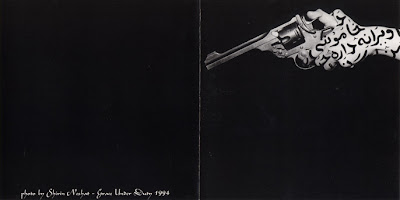

– Muslimgauze Vampires of Teheran, Staalplaat 1998, front cover
– Muslimgauze Re-Mixs Vol. 3, Staalplaat 1998, front cover
– Muslimgauze Hussein Mahmood Jeeb Tehar Gass, Soleilmoon 1999, inside cover
Do you use loops a lot?
Most of it stuff I couldn’t play in other set ups like the Hunter Gracchus. I guess loops are sometimes a poor surrogate for playing with people but again it also changes the way you play and create and interact with a drone.
Did you have in mind a particular atmosphere or aim at evoking a specific condition during production process? I am thinking specifically at The Gloriouos Gongs Of Hainuwele.
I don’t think it was supposed to be an accurate representation of anything in particular. At the time I guess I was listening to a lot of field recordings from Turkey, Iran, Afghanistan and the ex Soviet states from the 1900s to the 1950s. I was fascinated by that stuff and still am. Often the music didn’t seem miles away from punk was supposed to be. Some of it was the most apeshit stuff I have ever heard. Also the medium of recording was important. On some of the earlier wax cylinder recordings the medium is at the forefront clicks and woozing of machinery being loudest with only faint abstract remnants of the sounds that were actually being recorded being audible. These were equally fascinating.
Did you tour South America, right? What was the approach with the local musicians?
The Hunter Gracchus tour that was amazing. We played with and met a whole load of musicians and artists from Argentina and Chile. We played squats all over and managed to do some recordings. My favourite acts were 0+yn from Cordoba and GMC from Buenos Aires. Everyone was really hospitable and accommodating.
What about your videos? Yesterday night I saw it for the first time, except maybe the third one, which actually was on your myspace page.
Harry Wheeler (Architects Of Harmonic Rooms) put that one together from stuff he filmed in India using a super 8.
What about the other two?
The other two were made for this festival set (and then published on dvd by AAVV).
You took from a really wonderful archive.
There are a lot of horror schlock clips from all over the place including some Jose Mojica Marins stuff from Brazil and some Indian, Mexican and Indonesian horror. Some of these horror films are loosely based on folk legends like the Queen of the South Seas or Sarimanok. I have an affinity for certain types of horror even though most are shit. As a kid I used to love the bits of stop motion and animation and sculptures and outfits and nonsense narratives and surreal happenings you could find in them. I used to love watching films from half way or short segments so that events occurred out of context and seemed to be really fantastical. Often watching the film from the beginning to the end turned out to be a real let down. This is all the left overs and detritus. The stuff that’s not considered art or to have any merit.
Why this title, Old Man of the Mountain?
The Old Man of the Mountain was a 12th century leader of a Shiite sect I think in Syria. Most of the stuff about them is derogatrory from point of view of the Crusaders who they resisted and the surrounding Sunni majority again who they resisted. The legends talk about how the sect would take hashish and this would make them nimble assassins and they would go about taking out generals and leaders and generally causing chaos.
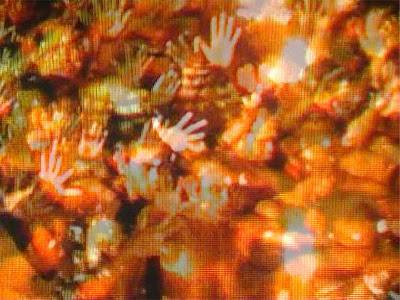



– Video stills from Old Man of the Mountain


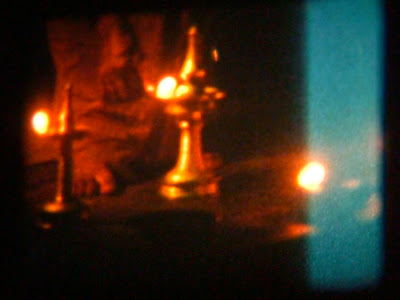
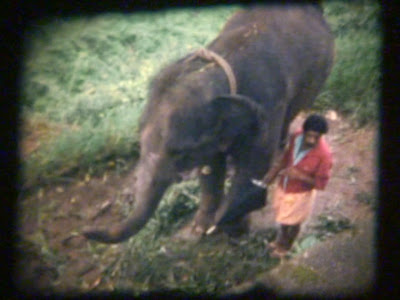
– Video stills from Headless Mule

